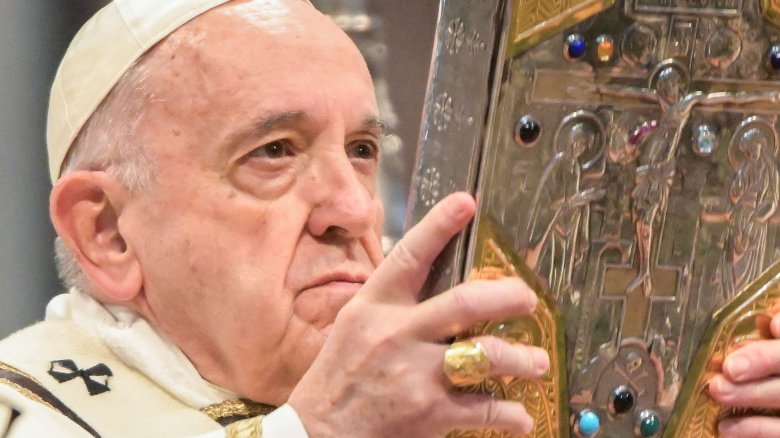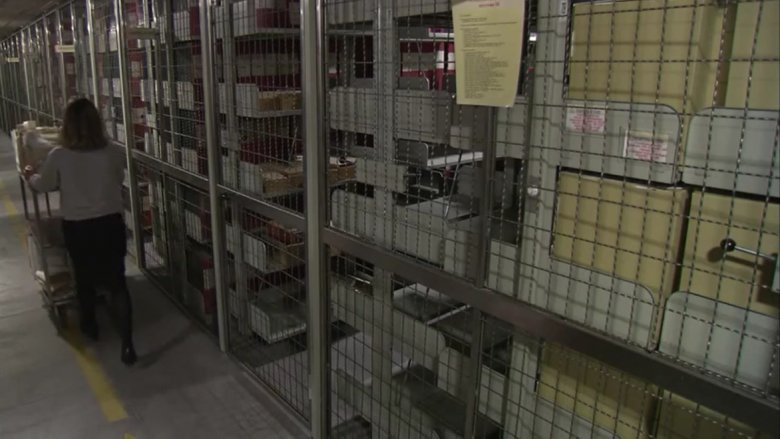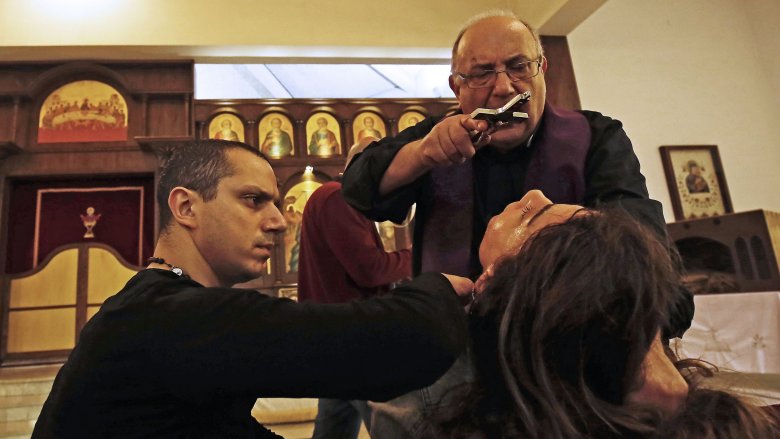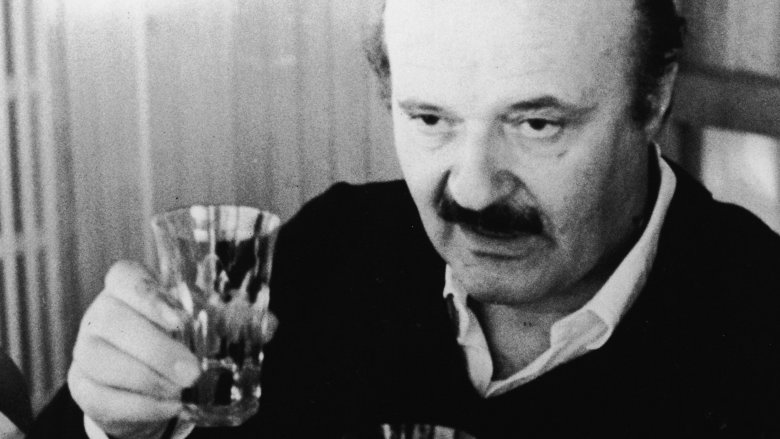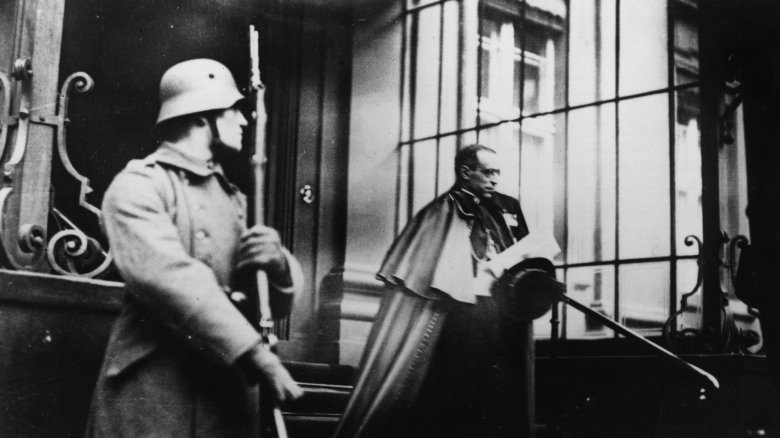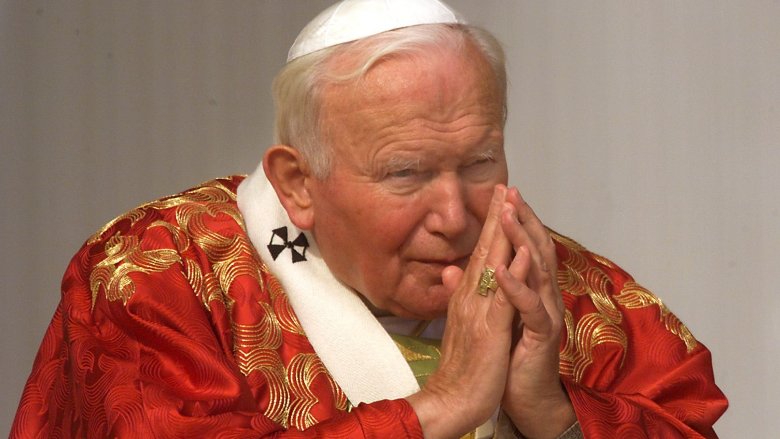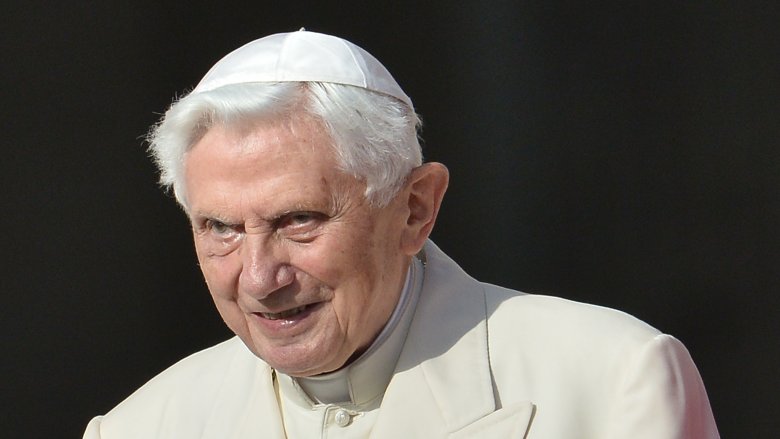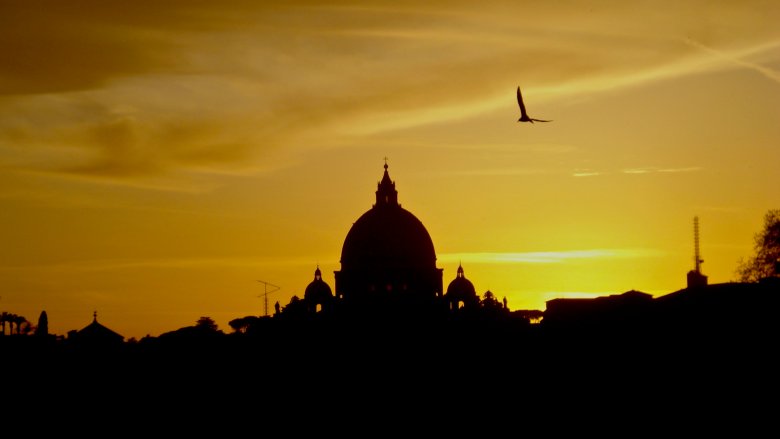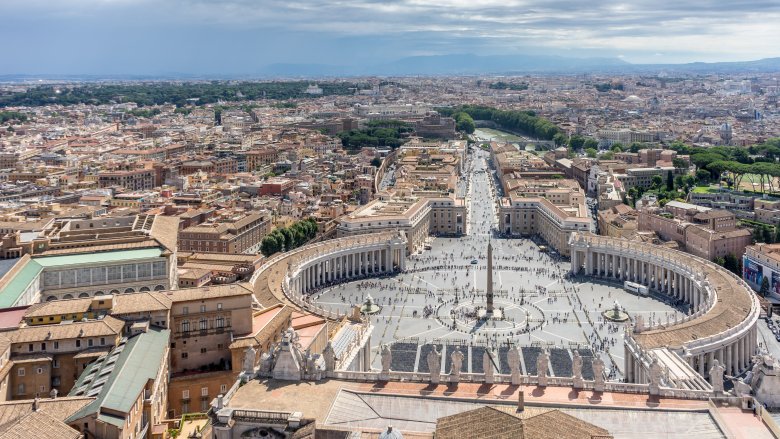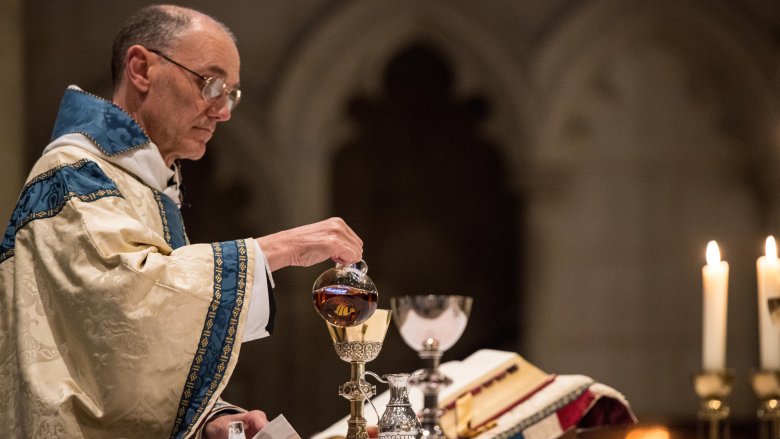Dark Secrets Of The Vatican Revealed
With an area of about 110 acres and a population of around 1,000 people, Vatican City is the smallest country in the world, contained fully inside the city of Rome, but its small physical size belies its somewhat outsized influence and power. As the home of the Holy See, the jurisdiction of the pope, Vatican City is the center of leadership for the Catholic Church, the world's oldest and largest continuously operating religious institution. As the home of St. Peter's Basilica, the Sistine Chapel, and the Vatican Museums, Vatican City is also a major cultural center. It's kind of a big deal. And as the heart of the world's largest Christian denomination, it's theoretically a sacred and holy place, where, like, God is present and stuff.
But reaching back to some of the Middle Ages' less savory popes and through the Vatican's independence from Italy being granted in 1929 by notoriously chill dude Benito Mussolini, there are definitely some less than holy stains on the Vatican's history. Setting aside conspiracy theories about aliens or Templar treasure and the abuse scandals you have definitely heard about, there are plenty of pretty gross things the pope and his pointy-hatted entourage would certainly prefer you not know about. Here's just a few.
Secrets of the Vatican Secret Archives
When looking at the secrets held within Vatican City, perhaps the most logical place to start is the Vatican Secret Archives. The name itself is evocative of mystery, and many theories have naturally arisen about what might be held among the 53 miles of shelves and 12 centuries' worth of documents only available to a select few. It doesn't take a lot of effort to find people claiming the Archives contain evidence of extraterrestrial life, proof Jesus never actually existed, or the true secret name of God, which has been handed down from pope to pope since 463 AD.
But as History points out, the Archives aren't really secret in the sense of being hidden from people; the word "secret" in this case means something closer to "private," because officially they house paperwork and correspondence relating to the pope. That said, the Archives are not fully public: they're only open to scholars who have passed a rigorous vetting process, and journalists were not allowed to see the contents of the Archives until 2010. Furthermore, documents within the Archive only become available for viewing even to this limited audience after 75 years. While the Vatican claims the reason for this is how difficult it is to process the enormous bulk of documents within the Archives, conveniently this means any documents relating to Pope Pius XII's actions during the Holocaust–minus the few released painting him in a favorable light–or the church's numerous abuse scandals are still restricted from view.
The Vatican's army of exorcists
While in the age of modern psychology and neuroscience it would be easy to dismiss exorcism as something from the Middle Ages and horror movies, the truth is the practice is alive and well within the Catholic Church. In fact, Father Gabriele Amorth, the former chief exorcist of the Vatican who died only in 2016, claimed to have performed a staggering 130,000 exorcisms in his time. As further evidence casting out demons isn't just a thing of the past, the BBC reports in 2018 the Vatican welcomed 250 priests from around the world to an annual exorcism school, because the Church believes there has been an uptick in demonic possessions in recent years. Even Pope Francis himself said people "must not hesitate" to see an exorcist in the case of "genuine spiritual disturbances."
Despite the controversy tied to exorcism due to its sensational nature and claims of abuse in their execution, such rites have been carried out even by popes in modern times. According to Father Amorth, John Paul II tried and failed to drive a demon out of a woman who was brought before him in St. Peter's Square screaming, writhing, and drooling in 2000. Father Amorth claims the woman was still possessed when he saw her later that day–as evidenced by her ability to walk up the wall like Spider-Man–and so he had to finish off what JPII couldn't. Likewise, Amorth claims Benedict XVI slammed the devil out of two guys in 2009, and some suspect Pope Francis may have performed a public exorcism on a man in a wheelchair in 2013.
The many scandals of the Vatican bank
The Vatican Bank, formally known as the Institutum pro Operibus Religionis ("Institute for the Works of Religion") or IOR, is a financial body riddled with scandal. The Catholic Church's primary financial institution has been embroiled in so many scandals since its founding in 1942, Business Insider was able to make a tidy little top five list based on the 2015 book God's Bankers. The bank was created during World War II to avoid the restrictions placed on financial transactions by the Allies, and as a result the Vatican Bank, being exempt from such restrictions, became the "world's best offshore bank." Since that time, the Vatican bank has become pretty notorious for its connections to organized crime, who use the Vatican's sovereignty to escape the scrutiny of world banks. In the 1970s, it's alleged the Vatican tried to purchase $900 million in counterfeit bonds and securities from a Mafia-linked operation, and in 2013 a priest was arrested for trying to use the Vatican Bank to smuggle millions of euros for the mob.
The most famous of the Vatican-Mafia scandals, however, is the collapse of Banco Ambrosiano, an Italian bank in which the Vatican was the main shareholder and which it used to launder money for the Mafia. After Ambrosiano's collapse, its chairman (who some believe murdered Pope John Paul I) was found hanged under a bridge, which was concluded to be a mob murder dressed up like suicide. Perhaps needless to say, efforts to reform the Vatican Bank have been in motion for several years.
The Vatican smuggled Nazis to safety
Following Allied victories in Germany at the end of World War II, Nazis suddenly found Europe a pretty inhospitable place for them and began to seek refuge elsewhere. Thousands of high-ranking Nazi officials, many of whom were war criminals (and the rest of whom were, at best, Nazis), managed to escape across the Atlantic to a number of South American countries, most notably Brazil, Chile, and Argentina. Most of these escapees managed to make their way out of Europe using routes through either Spain or Italy known as "ratlines." As a Guardian article on a book by Harvard researcher Gerald Steinacher shows, some of the travel documents that ended up in Nazi hands were given out by an overwhelmed–or occasionally over-sympathetic–Red Cross, but many Nazi fugitives were knowingly assisted by the Vatican.
While it's certainly likely some Nazis were unwittingly aided by the Vatican in their attempts to get Catholic war refugees to safety, Steinacher argues the Vatican chose to help Nazis because they had hoped for a revival of European Christianity and had a significant fear of the growing influence of the Soviet Union. Whatever the reason, the Vatican Refugee Commission unquestionably knowingly provided Nazi fugitives with false identities. The Vatican has consistently refused to comment on these events and the majority of the relevant documents have (as of 2019) still not been released from the Secret Archives. Allegedly Pope Francis plans to open the archives from this period to qualified researchers in 2020, so who knows what we might learn then?
The Vatican made money off the Holocaust
In addition to smuggling actual Nazis out of Europe and into South America, there is little doubt the Vatican also used its privileged sovereignty to help smuggle Nazi-looted gold, art, and other property belonging to Jewish families and other victims of the Holocaust. As Gerald Posner explains in an opinion piece in the Washington Post, efforts to get the Vatican to involve themselves in restitution efforts or even to open their war-era archives have been roundly rebuffed since at least the Clinton administration.
In his book God's Bankers, however, Posner investigates the possibility the war-era Vatican was up to something that was–shockingly, impossibly, somehow–even grosser than helping Nazis keep looted family heirlooms they had stolen from their murder victims. The Vatican's financial advisor Bernardino Nogara, the founder of the Vatican Bank, is said to have potentially been one of the Third Reich's spies in the Vatican, and–though the destruction of war-time records make the full scope of his plan unclear–he and the Nazis are alleged to have instituted a scheme wherein the Vatican invested in Italian insurance companies which kept all the assets from life insurance plans of murdered European Jews. Because the Vatican was just an investor and not the direct insurer, they didn't have to pay back any of the money they made in this scheme. If you think gambling on the lives of Jewish people, stealing from their heirs, and directly profiting from the Holocaust is the most ghoulish thing you can think of ... well, you're right.
The Vatican's $5 million cover-up
In the light of allegations of aiding and abetting the Third Reich, laundering money for organized crime, smuggling gold to help overthrow regimes, and seemingly countless abuse scandals, the idea of misappropriating tens of millions of dollars seems positively quaint by comparison, but nevertheless, a scandal and subsequent cover-up regarding some spendthrift monks in the 1970s proved to be very costly for the Vatican in terms of both money and reputation.
As reported by The New York Times, members of a monastic order in Philadelphia known as the Paulines raised money–in fact millions of dollars–for religious projects such as saying masses, building shrines, and renovating a cemetery, and did not actually do any of those things. Instead, these monks used these funds to purchase cars, televisions, stereos, and other luxury items a bunch of dudes who had taken a vow of poverty probably shouldn't have. The vicar-general used misappropriated donations to keep a mistress, which feels like at least a double no-no (i.e., a no-no-no-no), as well as stealing half the salaries of friends whom he had appointed to monastery jobs. Bunch of IRL Friar Tucks, these boys.
Despite stealing over $20 million in donations, the Paulines still managed to default on over $4 million in church bonds. The only way they were able to avoid lawsuits, bankruptcy, and criminal prosecution was through the intervention of the pope and the Archbishop of Philadelphia, who dished out over $5 million to quiet the Paulines' creditors and pay back their fraudulent loans.
Leaking the Vatican's secrets
In 2012, Italian journalist Gianluigi Nuzzi published a book called His Holiness: The Secret Papers of Benedict XVI, which was made up of pieces of private correspondence and other classified documents of the then-pope leaked to Nuzzi by Benedict's personal butler. This book revealed an inside look at the inner workings of the Vatican not normally afforded to the public, including–as The Huffington Post explains–evidence of widespread corruption and revelations the Holy See is home to rampant jealousy and backstabbing.
This leak scandal became known as Vatileaks, because of course it did. Even wilder, though, is–as The Guardian explains–when the Vatican started an internal investigation into the leak of these documents, they uncovered that individuals outside the Vatican were blackmailing an underground "network of gay prelates" who were allegedly holding gay orgies in villas, beauty parlors, and saunas in and around Rome. Many–including Pope Benedict's brother–believe the stress from these accumulating scandals contributed to Benedict's decision to resign from the papacy. This conclusion seems ... completely reasonable.
A second round of leaks–known, naturally, as Vatileaks 2–hit in 2015, again with a book by Nuzzi at the center of it, but as The New Yorker asserts, the sequel didn't have quite the same spicy excitement of round one. Whereas the original Vatileaks showed Benedict as overwhelmed and unable to control the cyclone of corruption around him, the second set of documents focus on Francis as a bold reformer trying to clean house within the Vatican bureaucracy. Sadly, no orgies in this one either.
The Vatican's secret court for super bad sins
In the Catholic justice system, some offenses are considered especially heinous. In Vatican City, the dedicated bishops of the extralegal tribunal who investigate these vicious sins are members of an elite squad known as the Apostolic Penitentiary. These are their stories. DUN DUN.
As The Telegraph explains, the Apostolic Penitentiary–also known as the "tribunal of conscience"–was founded by Pope Alexander III in 1179 and was basically shrouded in secrecy until 2009. The tribunal hears cases regarding sins so grievous, only the pope can grant absolution for them. Considering normal priests and bishops can apparently deal with confessions of genocide, you might wonder what kind of mega-sins get brought before this secret court. Examples include attempting to assassinate the pope, a priest breaking the seal of the confessional by exposing the identity or the sin of someone confessing, a priest having sex with someone and then forgiving them for the sin of doing it with a priest (yikes), performing or paying for an abortion and then trying to become a priest, or spitting out a Communion wafer. Yes, that is considered worse than genocide. The pope, acting through this tribunal and its head, known as the Major Penitentiary, then subsequently either grants absolution to the person seeking mercy or lets the automatic excommunication that comes with such grievous sins stand. Such cases are held privately and pseudonymously, as they are considered to be a matter of conscience and not public concern, which sure is a conclusion one could reach.
The Vatican is a hotbed of crime
Being the smallest country in the world–only 110 acres in area and with only about 1,000 official residents–means Vatican City is at the center of a number of mathematical anomalies. One of these is the Vatican has the highest crime rate of any country in the world, as the BBC reports. This doesn't mean there's more crime in the Vatican than any other country, just that more crimes per capita happen there (roughly one and a half crimes per person), and the gross number of crimes doesn't have to be that high for the ratio to become a pretty wild-sounding statistical outlier. It's pretty staggering to hear the Vatican–allegedly one of the holiest places in the world–has a crime rate 20 times higher than Italy–basically Pickpocket Disneyland–but you have to remember it's all about ratios and proportions. Additionally, these crimes are not, by and large, being committed by the pope or the Swiss Guards or whoever, but rather by the millions of tourists that stream through St. Peter's Square every year.
That said, the gross number of crimes isn't exactly low, either. Even the official Vatican tourism page admits the huge crowds of tourists make the Vatican an easy target for pickpockets, purse-snatchers, and shoplifters, and the crowds and corners can make sex crimes easier. The Vatican only has one jail, which is generally meant to be used for pre-trial containment but which is apparently used more often as a storage shed, and most judicial actions for violent crimes are actually carried out by Italian authorities.
In vino Vatican
While the per capita nature of statistics definitely skews perceptions of Vatican City in terms of the crime rate, it actually kind of makes things worse in terms of how much wine is drunk in the Holy See. The Independent reports residents of the Vatican consume more wine per capita than any other country in the world. In fact, the average resident of the Vatican consumes 74 liters–about 20 gallons–of wine per year. That's double the average of notably oenophile countries like Italy and France, triple the average citizen of the United Kingdom, and over six times as much as the average American. Presumably it's because we are too busy slamming White Claws or Tide Pods or whatever is in right now to worry about wine.
Of course the frequent consumption of sacramental wine at Communion does affect those numbers (but should it, since it's technically blood at that point?), but the Vatican's population features a number of demographic anomalies that make its citizens more likely to go HAM on some vino. By and large, the average Vaticano is older, male, upper class, and educated. Additionally, Vatican residents tend to eat communally in large groups. Each of these elements on its own contributes to a larger consumption of wine, so piling them all together gives you a person who probably brushes their teeth with Merlot. The fact that the Vatican's only supermarket reportedly sells wine duty-free probably doesn't hurt sales either.
